[Note from Brad: This is the first in a series of guest blogs from National Geographic photographers. Check back over the coming weeks for more stories about shooting for the prestigious publication!]
Crossing the Yellow Border
Kudos to Brad and Scott for devoting blog space to a series of posts by National Geographic shooters.
I’ve been shooting for “the yellow magazine” since 1987, and that land beyond the yellow border is indeed a wonderful, and strange, place. It contains and defines the entire realm of shooting experiences—impossible odds, magnificent occurrences, unprecedented access, nearly unbelievable bad fortune, outright danger, the exhilaration of the hard won chrome or file captured, and the devastation of bad days, or even weeks in the field.
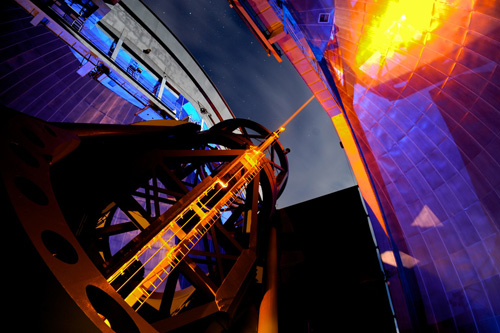
The Palomar Telescope fires a laser 60 miles into the heavens.
That place, “in the field,” can be the urbane and sophisticated streets of Paris, or someplace literally so remote as to have never felt the footprint of man. It can be the ultra-sacrosanct tombs and structures of societies time has all but forgotten, or the blinking, humming computers that power our most modern technologies. The magazine’s official mission statement is “to increase and diffuse geographic knowledge.” “Geography,” for the editors there, generally encompasses both physical and cultural geography. People and their places. People in relationship to the planet. The planet itself, in all of its’ magnificence, and wreckage. The earth, sea and sky, and all the organisms those elements nurture, and occasionally, punish.
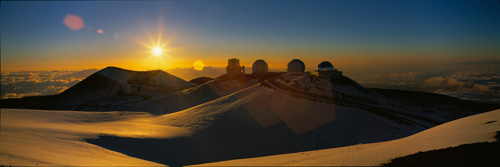
Over the Keck Observatory on Mauna Kea, Hawaii. I found that my fingers didn’t work so well trying to load a 617 Pano camera with 220 film in an open door chopper at 14,000 feet.
In short, everything. Trust me, I know this first hand. I was once given a story to do called “The Universe.” Yikes. (To my editor, I was like, “Okay, how long do I have to shoot this?”)
I was already an established “New York” shooter, with covers of Sports Illustrated, LIFE, Time, Newsweek, New York, etc., by the time I came to the attention of the yellow border gang. Strategizing to get an assignment, I turned down a go everywhere credential to the Seoul Olympiad for Sports Illustrated to honor a commitment to a week long freebie speaking tour called The Flying Short Course, sponsored by the NPPA. Sounds unbelievably stupid, right? A freelancer turning down a month of day rates to keep an obligation to do a series of free lectures.
On the face of it, yes. But the method to my madness involved being on the same touring faculty as Tom Kennedy, then DOP of Geographic. I had the opp right then and there to show my portfolio to Tom, five days in a row. I gulped, said no to SI, didn’t’ go to Seoul, and instead went off to lecture. At the end of that week of touring and talking, Tom looked at me and said, “You should come down and start shooting for us.” That was 1987. Still shooting for them. Finished my last assignment this past summer. Almost 25 years, and lots of yellow boxes, and pixels, later, I’m still out there, trying to increase and diffuse.
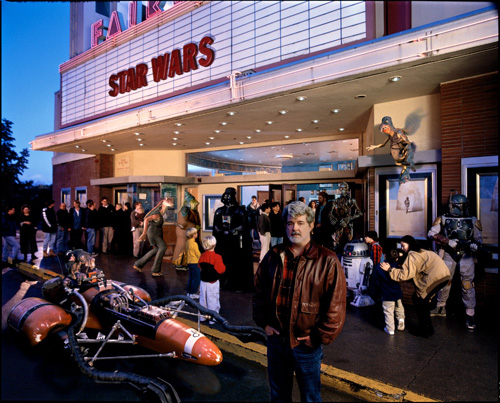
For a story on Global Culture, i needed a global storyteller. Who better than George Lucas? I wanted George Lucas to simply be part of the tableaux I created outside this old theater, but it didn’t quite work out that way. George is front and center, surrounded by his creations.
That longevity was not a given, to be sure. It never is in the world of freelancing, and I did my best in my first few efforts for NG to ensure my career with them would be truly short lived. I made big time screw up after big time screw up.
It was a different type of shooting, you know? I was used to the New York method. That kind of played out like this: Get a phone call from an editor at a weekly publication in Manhattan. Say yes. Never, ever be able to reach that editor on the phone again. Make all the arrangements, Go shoot the job. A week was a long time. Six pages was a big story. Get in, get out. Process film. Deliver it in a breathless rush. Not hear anything. Call three weeks later. Finally get the editor on the phone. “Oh, hi. Yeah, Joe! It is Joe, right? That story that you shot? Oh, oh, yeah. Oh, yeah, uh, it was good, we liked it. Thanks. Gotta go to a meeting.”
Have phone ring back, almost immediately. It’s a call from that very same editor you were just talking with. That editor who now all of a sudden remembers you, and realizes you are standing there, somewhere, with enough time to make a phone call and this qualifies you as a warm body with a camera, and potential availability to solve a problem the managing editor just threw on his desk like a big, steaming turd. “Hi, yeah, uh, by the way, are you busy in the next two hours?”
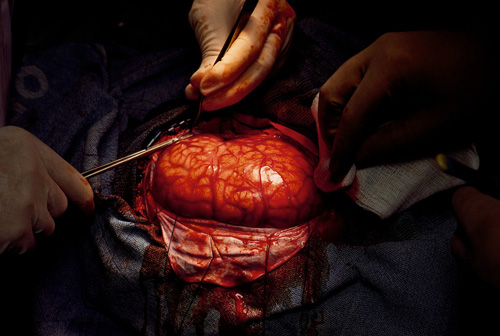
Shooting a story on the brain, I was just inches away from this incredible human marvel, during a dangerous, radical procedure called a hemispherectomy.
You laugh. There was a very nice gentleman at Newsweek named Ted Russell, who used to routinely call at the last minute. “Hi, uh, Joe. Uh, it is Joe, isn’t it?” “Yes Ted.”
“Good, uh, Joe. Say, you think you could get an assistant and your lights to Capetown, South Africa in the next 12-18 hours? We’re crashing a cover on Mandela.”
“Ted, does Mr. Mandela know he’s being shot for a cover?”
“Uh, no. But we figure you’ll work that out on the ground.”
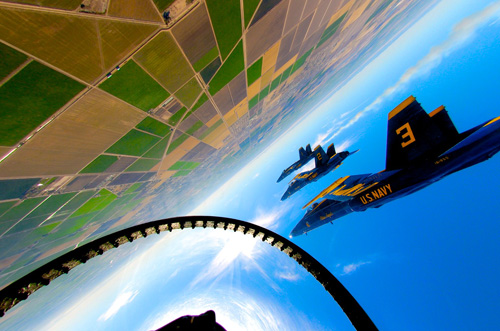
Up and over with the Blue Angels.
Geographic did not work like that, and still doesn’t. Geographic is considered, not breakneck. Geographic ponders, as you would expect they would, doing stories not for tomorrow’s paper but for a pub date that is sometimes two years out. Watching a story develop at NG is kind of like watching one of those slow, shuffling herds of elephants moseying through the savannah, clouds of dust everywhere, that are routinely portrayed on the Nat Geo TV channel. In contrast, shooting for New York based weeklies, at least when I started, was kind of like being a squirrel on speed.
The first thing I was assigned to do for National Geographic was a “fix” on a story on Washington State. I was given three weeks to shoot this. Three weeks to shoot a fix? Holy sh!t. What was broke?
Whatever it was, I was told I broke it even more. I was crushed. First time out of the gate, and I flopped. I, of course, was more upset about it than they were. I thought it was over before it began, but then they called me back. They had a package of stories they were working, on immigration, and would I be interested in shooting the historical port of entry, Ellis Island? Small story, by their lights. Fourteen pages. Gave me a month to shoot it. Yikes.
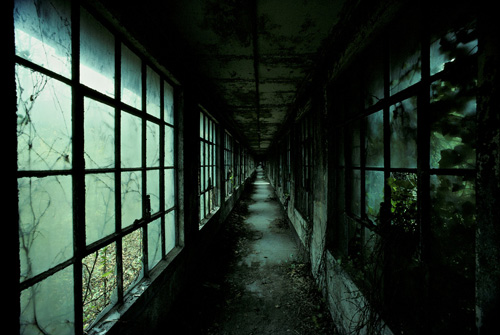
Long hallway, abandoned section of Ellis Island.
It was a home grown story, sitting out there in the harbor. I began to get up every day at 3am and trek my way to this frigid, largely abandoned island. No people. Just me, the rising light, and the ruins of what was once one of the most bustling places on earth.
Of course, I knew why they had called me back. The main building of the island, the Great Hall where all the immigrants were processed, had to be shot. At the time, it was being renovated, and was a powerless, under construction shell. So, to shoot it, I had to light it.
It was the biggest lighting job I ever tried. About 65 power packs, and about 100 flash heads. Couple hundred thousand watt seconds, all going off at once, powered by a huge generator truck, which I got onto the island by dishing $1000 cash under the table to the construction site super. That was another reason to hire me. I knew how to work in New York.
It was December in the middle of the harbor. Power packs were freezing, I was freezing, and my beleaguered crew was damn near mutiny. It took four days, virtually without sleep. I’d shoot sunrise, and then have to process the film, and make adjustments. By the time the adjustments were done, it was time for sunset. So it went for almost a week, just to get one frame, which ultimately ran a half page. For this effort in the field, Nat Geo paid me $250 per day.
That was it. You see, I wasn’t really a Geographic shooter yet. I was in test phase, you could say. They would pay you minimally, a kind of entry level wage, during your first efforts back then. Kind of like throwing a very small bone into a snarling pit of freelance photogs, and stepping back and seeing who comes up with it, which I’m sure was an entertaining process to watch. The Geographic illustrations editors didn’t much want to work with a newbie, either. The budgets on these jobs made them cautionary items indeed, and while you were in the field, you basically had your editor’s job security in your back pocket. You fail, and they would take heat back at the ranch. Hence, many were hesitant to work with a rookie. They wanted Stanfield, Richardson, or Johns. All tried and true veterans, who knew how to deliver their style of coverage. Understandable.
I found out downstream that Ellis Island was well received. During the job, my editor was pretty inert. He would take my calls only occasionally, and rarely returned them. I didn’t go to DC for a big showing, like I had been told about. I just shipped in my Kodachrome, and waited for judgment. Cool by me. No different than working in New York!
Then, Kennedy called me in. There was another story in trouble. The shooter had missed by a wide mark, even after weeks in the field. The story was London Docklands, also a large construction site, this one on the River Thames.
Tom looked at me. He said, “We’ve already done this story and failed. Many editors here feel there is no story there, but the managing editor feels strongly about it, which makes it precarious for you. If you fail, you’ll never work here again. But, I want you to take this story.”
How could I say no to such a cheerfully described opportunity? I toddled off to London for 17 weeks, at $250 per day, with only one break to come home. I was given an editor who was basically retired at work. She was quite fond of the original shooter on the story, and disliked this turn of events, and hence, me. So, she gave me none of the research that had already been done, and did not look at a single frame of the nearly 1,000 rolls I shot.
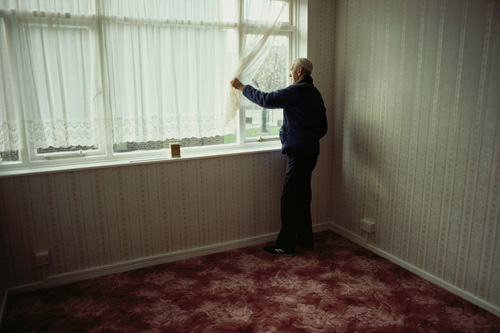
Dislocation in the East End. The Docklands project uprooted many traditional neighborhoods. This new apartment was actually better than George’s old one, but it wasn’t his. I needed to show his sense of being lost, as I observed him moving about his new digs. He grew up in the East End, and he survived the blitz there during the war. Product of a large family, he told me, referring to the loaves and fishes, “When it came to feeding the masses, my mum had Jesus Christ well and truly beat.”
Thankfully, back then, Geographic had film review. It was a check and review stop your film passed through to make sure your cameras were working, and all things technical were on the up side. Kennedy, knowing my editor was out to lunch on this one, would wing through there and grab a view at a few frames, and tell them to call me with this message. “Tell him he’s failing.” He was sincerely trying to be helpful, in his own blunt way.
I thought I was going mad. I looked through the lens listlessly. Then, Sam Abell saved me. A wise, veteran shooter, I sought him out in my one break, and showed him copy Polaroids of my Kodachromes. I told him I was flat out crashing and burning, and in the field, I was like an airplane pilot who had lost altitude, airspeed, and ideas, all at once. Sam looked at the lot of postcard size images. He turned to me, and said, “Joe, just keep doing what you’re doing. The photography’s well in hand.”

Scene in a pub, East End of London, Isle of Dogs
That’s all you need somebody to say, right? Thus buoyed, I actually had the strength to pick up the camera again, and I bore down for the ensuing stint of nine straight weeks in the field. The story got upped in page count, which meant they liked it.
Kennedy called again. No story in trouble this time. It was a science story, called The Sense of Sight.
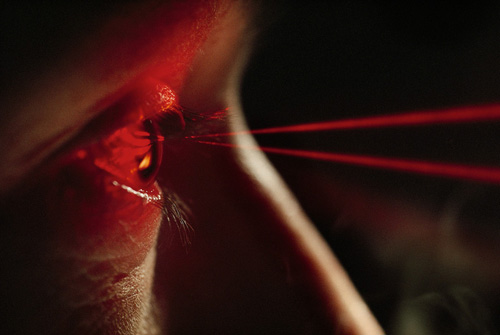
Eye diagnosis, using the aiming beam on a laser. The only successful frame of this take, and it ran as the lead photo.
It was a round the world opportunity to examine the phenomenon known as human vision. Can you imagine? As a photog, I got a chance to study, shoot, and explain to others the marvel that is the human eye. The contract was for 26 weeks, at $500 a day. It was like getting called up to the bigs from rookie league ball. It remains the most complete opportunity I’ve ever had as a shooter. The proving ground had worked. I’d passed my tests. They were now really willing to risk something big on this bedraggled numnuts of a NY shooter. And I do mean risk. The bigger stories at Nat Geo had price tags way into six figures. Lots of planning, research and dough went into putting you, with a camera, in a place where the wild pictures are.
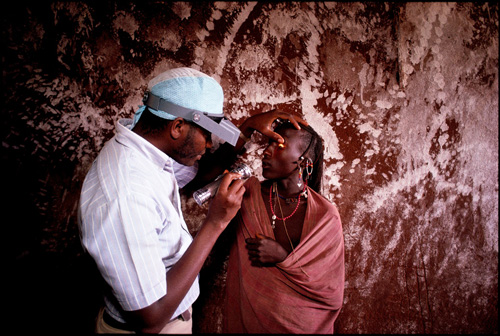
Sidney Katala does an eye check in a tribal village, central Tanzania.
It also brought me together with Bill Douthitt, who has been my editor, and friend, on ten stories over the years. A true renaissance man, he knows more stuff about more stuff than just about anybody I know. Having him in your corner, shaping the story, editing your images, listening to your rants, and re-directing your overheated imagination, is what it means to really, truly collaborate. He’s always been a source of support and encouragement.
For instance, he once wrote to me that “a perusal of your latest take indicates you’re approaching the story with the zeal and vigor generally associated with the better varieties of shrubbery.” It’s basically like working for @ShitMyDadSays.
It’s not an easy passage, this yellow border crossing. There’s heartbreak and failure along the way. There’s emotional discord and stress, both in the field, and at home. There’s constant risk, and exposure to things that are strange and new. (Which is great fodder for photographic zeal, to be sure, but fatiguing at the same time. After four or five weeks of eating stuff you don’t ask questions about, sometimes, you just want a cheeseburger and a coke.)

For a story on the human brain, I spent time with Hobo Ron, in a lean to, makeshift shack off the highway. His erratic, occasionally dangerous behavior was an important piece of this coverage, which had to show the problems of the mentally ill homeless.
There’s loneliness. Sometimes you are in a place where you can only communicate with your fixer, and virtually no one else, given language barriers. Given the ongoing stress of feeling like you’re shooting garbage, you get literally jack hammered by your own uncertainties and insecurities. (Feel nervous about digital storage, and not losing your images out in the field? Try shipping 75 rolls of Kodachrome back to DC from Mumbai in a bag. When I would do stuff like that, I literally could not eat until I got word the film had arrived safely.) You travel by yourself, cross dicey borders, get harassed and questioned. Anyone out there who thinks a letter of assignment from National Geographic confers upon the bearer a Moses-like ability to part waters and make great pictures happen, is just, well, wrong in that assumption.
It’s not for the faint of heart, in short. There are photographic rewards, to be sure. That sight assignment was exactly as Kennedy described it on the phone to me that day. It was a gateway. Cross this bridge, and school’s out. You can call yourself a Nat Geo shooter.
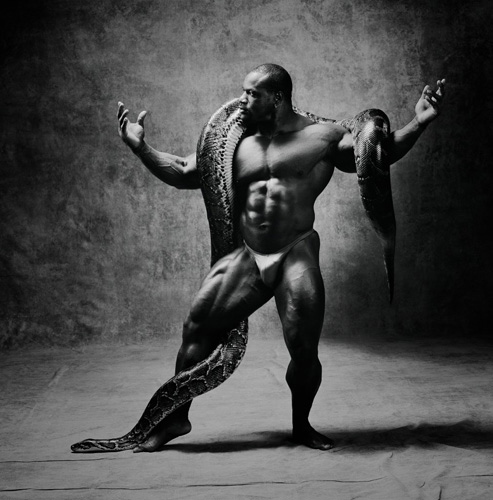
For a story on human performance. I tried to indicate “coiled strength” by wrapping a world class body builder in an 18′ Burmese python.
At the behest of the magazine, you see marvelous, not to be repeated things. You witness the great trends and developments of our time, and turn your lens on stunningly beautiful stuff, along with heart breaking moments. You observe the tilts and whirls of culture, science, nature, and human behavior in a special way. And you bring back visual dispatches that become a window on the world for some 30 million pairs of eyes. Very cool, and, a huge responsibility. You also live in fear that when the moment happens, the one you’ve come for, you will miss it.
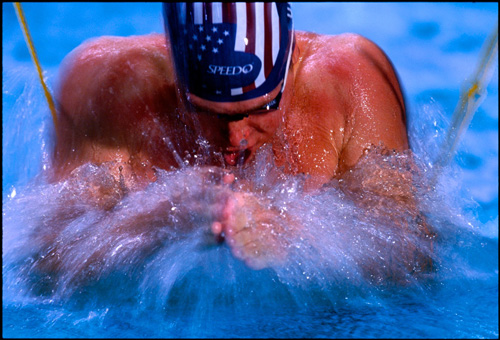
For the human performance story, I got the camera into the pool with Olympians.
And, here’s a small thing, a perk if you will, of pushing yourself down this occasionally precipitous and never smooth road. You get to be in this small group, a club, that carries a very hard won membership card. For the last 30 years, the folks who have pulled the picture wagon for the yellow border magazine number no more than say, a hundred.
Every year, in January, the yellow magazine calls together its’ shooters for a couple days of meetings. There is a photog’s lunch, and we are a small number, in a relatively small room. There is, in addition to exhaustion, tension, and uncertainty about the future, a ripple of quiet pride in the room. There’s also jealousies, bad feelings, and huge egos. After all, it’s a room full of photogs.
At the beginning of the lunch we have been traditionally asked to go around and say no more than an introductory sentence or two about ourselves, in case there are new people there. It passes around, and people simply say something like, “I’m so and so, and I just shot the recent cover on such and such.” Or, “I’m so and so, and I’ve been shooting for the magazine for 22 years.” Bits and pieces like that. Snippets.
At the last one I was at, a very esteemed and talented photographer, a mainstay of the business for many years, who for some reason never had the chance to shoot for the magazine, was there. That year marked his first published coverage and thus his first invite to the lunch.. He introduced himself. “I’m….”
Then he paused, smiled, and looked around the room. “And I’ve been waiting the longest to be in this room.” He sat down to applause.
More tk…
You can see more of Joe’s work at JoeMcNally.com, keep up with him on his blog, and follow him on Twitter



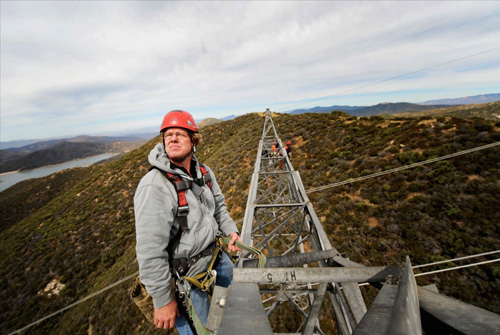
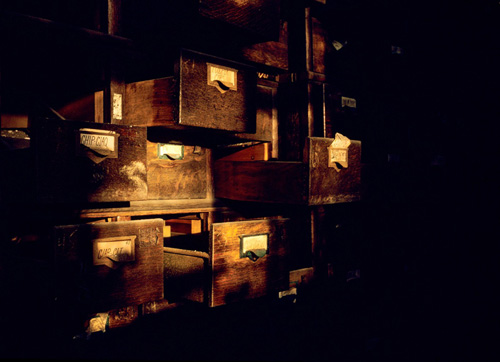

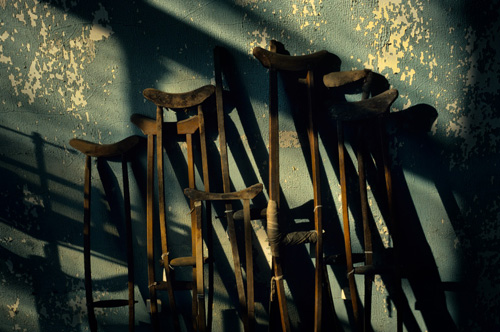
Joe, you are one cool dude. I’ve learned so much from you in the last decade, I so look forward to seeing you and taking the Safari every year at PSW! This is one of the best blogs ever! Hope to see you soon (thanks for the DVD).
KT
many thanks back to one cool dude!
Wow, what a magic carpet ride. Thank you for taking us, so to speak, on this incredible trip and journey. Amazing.
Wow one of the best articles on photography I’ve ever read. I read a lot of blogs and read a lot of articles but this article stands out on top. I couldn’t stop reading it because it was so interesting even though I have no intention of becoming a National Geographic photographer. Thank you Scott Kelby and Joe McNally!
Joe, you should really think very hard about publishing a collection of columns like this one. They are so well written, funny or heart-breaking at times, that I just know non-photogs will want to read and enjoy them. You could publish them as a prequel to your auto-biography “The Life and Times of Numnuts, a Photog”!!
Thanks for sharing your incredible journey. I can’t wait to read more.
WOW, incredible job and excelent photos.
What a great post this is. Truly mentions what it takes to be a good photographer. I was simply stunned reading the amount of lights and packs you had used to light that building, no doubt you are the master of lights.
Very inspiring read.
“There’s also jealousies, bad feelings, and huge egos. After all, it’s a room full of photogs”. Interesting :)
This is terrific. Thanks for putting it together for us. Much appreciated.
Joe it goes without saying your talent with photography and lighting is great. I sometimes think your writing gets overlooked. You are a terrific storyteller. Love your humor.
Thanks for sharing the dream of a lot of photographers.
Simply amazing!
Thanks Joe. As usual, an excellent, honest and inspirational read.
Graham.
Joe, I’ve always been a huge fan of your work. it’s nice for people to get a realistic view of the world from the other side of the lens. You’ve got so many of those once in lifetime, never before seen shots, it makes me stand back and say whoa…..nice stuff !
Joe,
you always take those easy assignments.
Wonderful to revisit this body of work!
Safe travels today, and always,
Michael
Joe, great, read as ever. Inspiring, as always. Is there anywhere on the web that the London Docklands images can be seen? I live in London and remember the changes well. It’s such a different place now! Would be great to see them…
Excellent blog post, Joe. I agree with wvdjr above that you should put these essays together in a book.
I’ve attended a couple of your classes and find that I always learn something new. Too often, lecturers give the same spiel at their seminars. You always find a way to put a new spin on lighting techniques. LOVED the Flashbus tour! Keep up the good fight.
–John
The Wow factor is off the charts on this post. There seems to be no end to your fascinating stories in capturing your images. I too have learned much from your classes, books, and PSW Safari and I thank you Joe.
Wonderful Post!!
Best of the best of Joe’s!
Very interestingly written with Joe’s usual humor and field insight.
Saving this blog to read it often…
Thanks Joe, Scott and Brad!!
–Ram
Joe,
This blog makes me feel the same way as the first time I sat in the dark and listening to you talk at the Kentucky Derby Workshop…you are not only an amazingly talented photographer, but your stories are real and take me with you behind the scenes…I could listen to your stories all day!
Joe your words of wisdom and experience along with your photography is always inspiring. As a fan on National Geographic, I’ve always dreamed of being a photographer for them. Hearing your experiences with Nat Geo does one of a few things for me: a. it scares the buh-jeezus out of me and b. makes me wish I had the fortitude to pursue the dream of shooting for them even more.
But at this stage in the game, I guess I’m going to have to vicariously live that life through you, your words and pictures…. it seems safer that way anyways. :)
Awesome story and thanks for sharing these memories. Also, thanks to Scott and Brad for the idea of having Nat Geo photographers as guests for the blog, nice idea guys!
Scott and Brad have done a cool thing. Upcoming posts from some amazing, talented Geographic shooters……stay tuned, and thanks for the kind words…Joe
Joe, are you taking over Scott’s blog? All these posts from you these days! :)
Thank you for sharing with us so many precious experiences, stories that you have. It’s a wonderful encouragement and truly inspiring! I wanna say I wish to have your experience, but not sure if I can go on a blue angel jet, climb the WTC antenna or stand on the side of a flying helicopter.
Joe, that was once again entertaining, insightful and fun. I love your books and posts like this and on your blog. Not to pressure you, but I’m ready for your next book :). Always enjoy reading your thoughts and stories! Thanks for sharing your life with us.
Loving the photo of the Keck Observatory. The body builder and the snake pure awesomeness.
How can a guy who’s such a great photographer, also be such a great writer?
Joe:
I would give anything to do what you have done. My dream job is working for the “Yellow Magazine” … I have had the opportunity to travel the world and photograph many things while in the military, but still yearn to shoot for Nat. I fell in love with photography 20 years ago and still going strong.
Most blog posts get a quick read or skim for the nuts and bolts – not Joe
Most photos get a quick glance before moving on – not Joe
Most videos embedded in blogs I skip watching – not Joe
As something of a writer (albeit of limited skill) myself, I am continually amazed at how I continue to hang on every word you write – how do you do that?
As something of a photog (albeit of limited skill) myself, I am also continually amazed at how your images continue to blow me away – how do you do that?
Another home run here…tks.
thank you for the peek into your world! Wonderful!
Thank you so much, Joe! I first met you in San Diego last December at a lighting technique seminar you conducted. Since then, I’ve jumped into ‘the deep end of the pool’ to pursue my photography endeavors. I traveled to England and Wales to shoot landscapes, and most recently, I traveled to Gabon and participated in presidential festivities, celebrating the 51st anniversary of the country’s independence (I even had the opportunity to meet His Excellency, Ali Bongo Ondimba (the President of Gabon) before the end of my trip. Thank for sharing your stories, experience and expertise with the rest of us. It is truly inspiring!
Great article from the master :-) … I’ve loved National Geographic all my life. Also a fan of another NG photographer Carsten Peter. His work is amazing as well.
Joe, as always, you have shared a piece of your life with us. Thank you for sharing your insights, experiences, & your photos.
Fabulous article, you are a man of many talents. Not only are you an incredible photographer but an awesome storyteller as well. I always appreciate the honesty and directness of your posts.
Thanks for sharing!
This was a fantastic read. It was both eye opening and inspiring.
Can’t wait for more.
Thank you for sharing.
Thanks for sharing your journey Joe. What I admire most about your story telling is how you, well, make one feel that you were right there with you – speaking with and living it with you. No one I know of is better at this than you.
Now your photographic talent … speaks for itself. I hope one day I am fortunate enough to take a class with you. In the meantime I thank you for all your books and online educational opportunities. They have helped me so much.
Another reason to go out and buy the Nat Geo DVDs with all 122 years. The photos alone are worth the price. Great story. Those Nat Geo stories in war torn areas really make me respect both the writer and the photographer.
Joe – I love your blog, your photos and I have learned so much from reading your books. You are a magnificent story teller in both your pics and your words, love them all! I’ll stay tuned for more….
All I can say is… Wow! Hats off to you Joe for your dedication to bringing us the story.
Joe it is always a interesting to hear your perspective of being a shooter, especially this post from inside that yellow border. Thank you for sharing your experiences with honesty and humor.
Hey Gang…many, many thanks for taking the time to read and visit. It’s a long strange road, to be sure, but one worth traveling. All the best to everyone out there with a camera in hand. It’s a tough (sometimes) but wonderful thing to do….best Joe
Awesome and insightful post Joe! Love your photography and appreciate you sharing your story. The video was amazn and fun to watch! I couldn’t wait to share your post today:)
As ever, amazing pictures and superb narrative. Thanks, Joe – it’s always a pleasure to view and read your work!
Fabulous read.
Balliolman,
England.
I’ve followed Joe’s work since college and meeting him in Indianapolis this year furthered my respect for him and his work. Not to mention he’s one of the most kind and best photography teachers out there. The world and photography community could use a lot more like Joe!
Joe! Such a great blog post!! I refer to both your books constantly when I am doing a shoot. Not to mention outright bursts of laughter when I read what you write. Keep it going:)
Its a very nice read, Joe! I always enjoy your stories! Besides that love to see material from you that I have never seen before.
Jakob,
Of Switzerland – Way behind the yellow boarder:-)
Wow! “Not for the faint of heart“ is right!
Thanks for the insight, a real pleasure to be able see the “inner workings“ though your eyes and very informative writing.
Joe,
As another guy that loves to shoot sports, I’m sure you’ll get the humor when I say, “I hope one day to be able to carry your camera strap.”
Woa, numnuts has balls! :-)
Joe, unknowingly you have helped me become a full time pro after 40 years of passion for the craft . I’ve attended a couple of your Dobbs Ferry classes, returning home with renewed energy and the feeling that “I can do this!”. Well easier said than done, but you showed us the way and, especially, that it is OK to make mistakes. That was my greatest takeaway, removing the fear of trying things out and making lots of crappy images before one makes the cut. You are also an excellent writer. I hope you have a biography in the works. Best, Claude
Hi Joe. After reading this blog and all the comments, which I totally agree with, all I can add is another WOW! Thanks for sharing something which most of us will never experience.
Marty
Joe’s stories with words are just as wonderful as the stories he tells with photos. Bravo!
this is a wonderful post, Joe!!… a great source of inspiration and strength!!
always wondered how to write great stories about photography….. well, this looks like a tutorial to me!!
What a great read! Thanks for sharing this, Joe!
McNally is one of the very few I would not mind paying just to hold one of his lights on one of his shoots.
Hello Scott, I was wondering if there is an email for us to talk about something I`ve been thinking for a long time. I`m a Brazillian and I love Kelby Trainning, but everyone that I recomend the website is frustated, because they can`t understand english (yeah, some people didn`t study english here in Brazil).
What I was thinking is to help the website by listen to the lessons and started adding subtitles on this videos.
Tell me what do you think, that way you can enter in another markets that dont have english as the 1st language.
Waiting for your comments
Joe has a way of romantically describing a tough situation so that instead of feeling jealousy for his great successes (as you might feel if someone of less tact were boasting about their accomplishments), you feel proud of what he can overcome. Thanks for the insight, Mr. McNally!
I love reading Joe’s insights into life and the “field” Great article.
Great post! Loved the video at the end.
I think people should also know that most shooters wouldn’t have the guts to climb out on the very top of the Empire State Building, at night, in the freezing wind and mist, and then scale up the radio tower, all to get a shot. Or be deposited from a helicopter on the top of a giant high voltage tower in the mountains and then shoot from hundreds of feet off the ground. Flying and shooting with the US Navy Blue Angels? Cmon, most who think they could, would chicken out at the last minute. Not only can the guy work a camera, he will go where 99% of other shooters would say, ‘No way, thats insane, I draw the line on that….’ And his style of shooting always contains elements of danger, risk, beauty and heart. His New York City Firefighters and 9/11 images are extremely emotional. NG is lucky to have him…
Wow, this was really inspiring stuff. It’s reassuring the see that even accomplished experts get downhearted and challenged. Obviously the trick is not to give up. Looking forward to part 2.
As always, Joe – great, great stuff. Thank you agsin.
Ellis Island – Back in 1984 we asked my wife’s elderly aunt what she remembered about Ellis. She must have been seven or eight at the time. She said it was very quiet. You couldn’t make any noise. Why we asked? “So you could hear when they called your name.” Who would have thought.
Flat out the best post ever. Inspired me to take it up a notch. It’s not about the money!!
Fascinating reading and – of course – great images!! Thank you for sharing!
Scott and Brad… That was a great idea. If all the future posts are at this level… You got yourselves an amazing book (I’ll be the first one buying it).
Joe… I loved the post… Made a fan become a bigger fan. I just feel sorry for the next NG photographers that will write here… You set the bar way too high… :)
Thanks!
WOW!!! Totally inspiring!!
Dear Santa, please can I have a coffee table book full of Joe’s ‘favourite’ shots of his own taken over the years.
Thank you,
Glyn Dewis (Aged 40…nearly)
Glyn, I think you’d need a re-enforced coffe table to take the weight of such a tombe ;-)
Thanks for sharing Joe – beautiful imagery & words as always.
The wit and wisdom of Joe! As always, a good read..
Incredibly inspired and touched by Joe’s images and writing, but especially his humility. For those of us (and by us, I mean me) crying over our tiny amount of facebook fans and whining about our lack of recent bookings, there are many takeaways here. The least of which is that patience and perseverance are essential qualities that you must have in the business. And that even amongst the best shooters in the world, there is no such thing as over night success. Thank you for this piece.
Amazing read – it stirred a lot of emotions in me. Thanks for sharing such an amazing life story!
… inspiring … :-)
Wow! What an inspiring read!
While I do not hope to aspire to one day be a NG shooter (though it would be quite a thrill to be such), I do find that there is much joy and fulfillment in shooting the subjects I do here in the US Midwest. We do share the rush of adrenalin when we grab that image, as well as the crush of despair and loss when we miss it. In the long run, I have to remember that a career in photography is a “long run”, full of work and practice and discipline. But whether we are internationally acclaimed or only locally known, over time, we do have something to show for it all. Thanks for that reminder, Joe.
Scott, Brad, Joe,
I just got a chance to read this after some computer hickups. I’m glad I did.
Wow, what an incredible read.
Thanks Joe I’m sure we’ll meet again at another Photoshop World.
Mike
Amazing stuff. One of the most enjoyable blogs I’ve read in a long time.
Incredible pictures, they all look awesome!